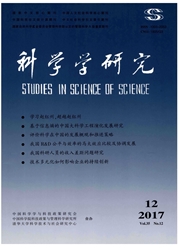

 中文摘要:
中文摘要:
专利和论文是研究机构的重要科研产出。基于1995-2012年中国研究机构的非均衡面板数据,采用NB和ZINB计数模型以控制专利和论文存在"过度散布"和"过量零值"可能产生偏误的基础上,本文首次深入分析了中国研究机构的科技投入结构、改制对专利和论文产出的影响,研究发现:(1)研究生学历科技人员对我国研究所的专利和论文产出的影响最大,其次是非研究生科技人员,科研业务费和科研设备费对科技产出的影响非常有限;(2)改制对研究所的科技产出有重要影响。与未改制的研究所相比,科技型企业申请更多的专利,论文产出相应减少,而NPR专注于基础研究,论文产出显著增加。本文结合研究结论对研究所的科技资源优化及分类管理提出相应的政策建议。
 英文摘要:
英文摘要:
Patent and paper are important scientific outputs for research institutes(RIs). Utilizing NB and ZINB count model to control the possible biases from the zero-inflated and over dispersion,we for the first time evaluates the impact of various of ST inputs and characteristic variables on the output of patent and paper based on a panel dataset consisting 1813 of China's research institutes from 1998-2005. We obtain three results:(1) ST personnel without graduate degree is not significantly promote the output of patent. Among the other three ST inputs with the positive estimates,ST personnel with graduate degree have a larger impact on the patent output. The impact of ST intermediate inputs on paper is not significant. Among the other three ST inputs with the positive estimates,high-level ST personnel have a larger impact on the paper output.(2) Compared with the RIs supervised by local government,RIs by central government publish more papers,and apply less patent. Compared with RIs located in the eastern region,RIs in central and west region apply less patent. Paper publication is not significantly different among the three regions. RIs located in manufacture industries have more patents and less papers,and RIs in public service industry have less patents and more papers.(3) Compared with the non-converted RIs,ST enterprises apply more patents to satisfy the demand of innovation market,however,NPR and NPNR,which focus more on basic RD and public services,significantly increase their publication.
 同期刊论文项目
同期刊论文项目
 同项目期刊论文
同项目期刊论文
 期刊信息
期刊信息
